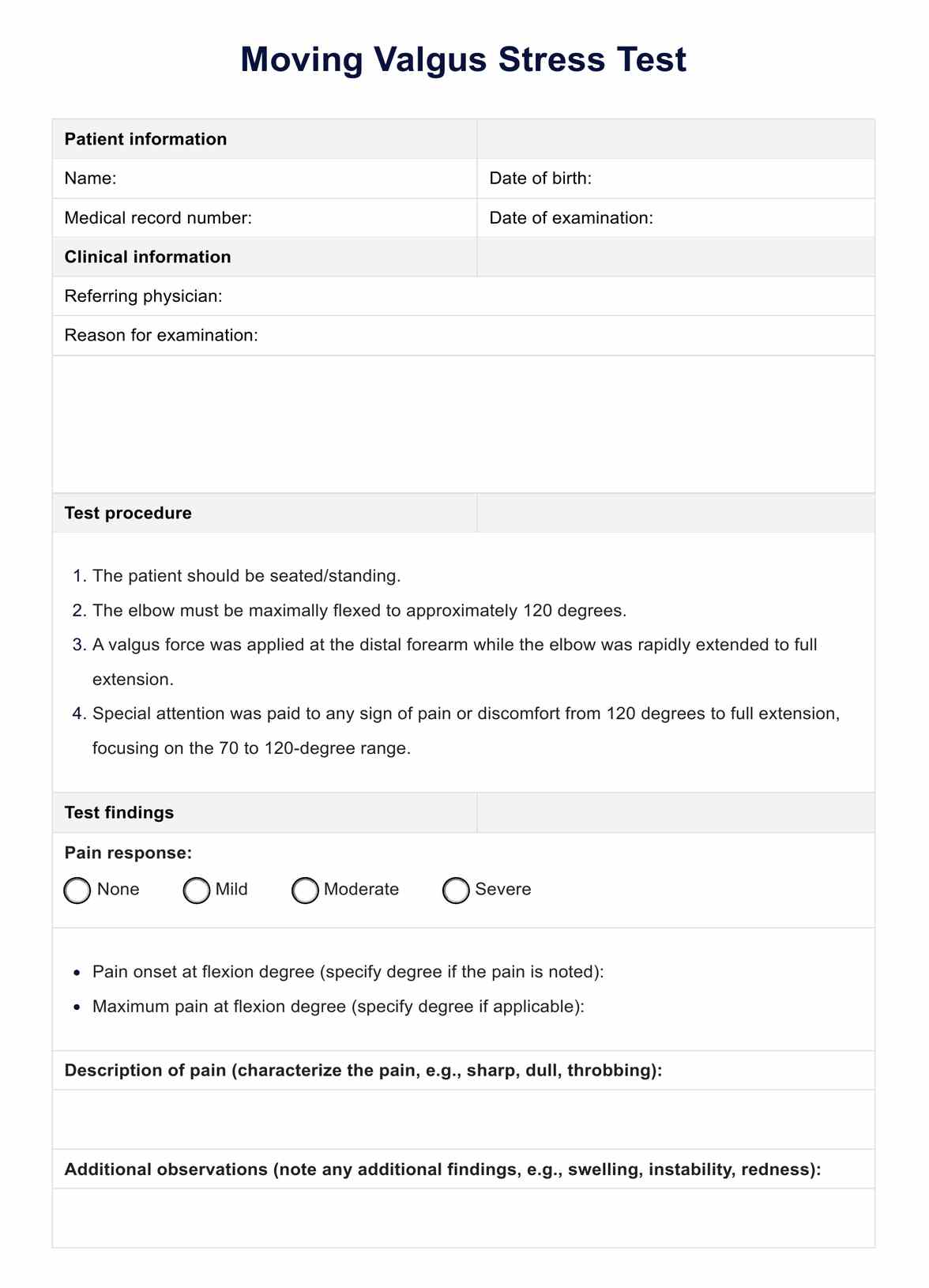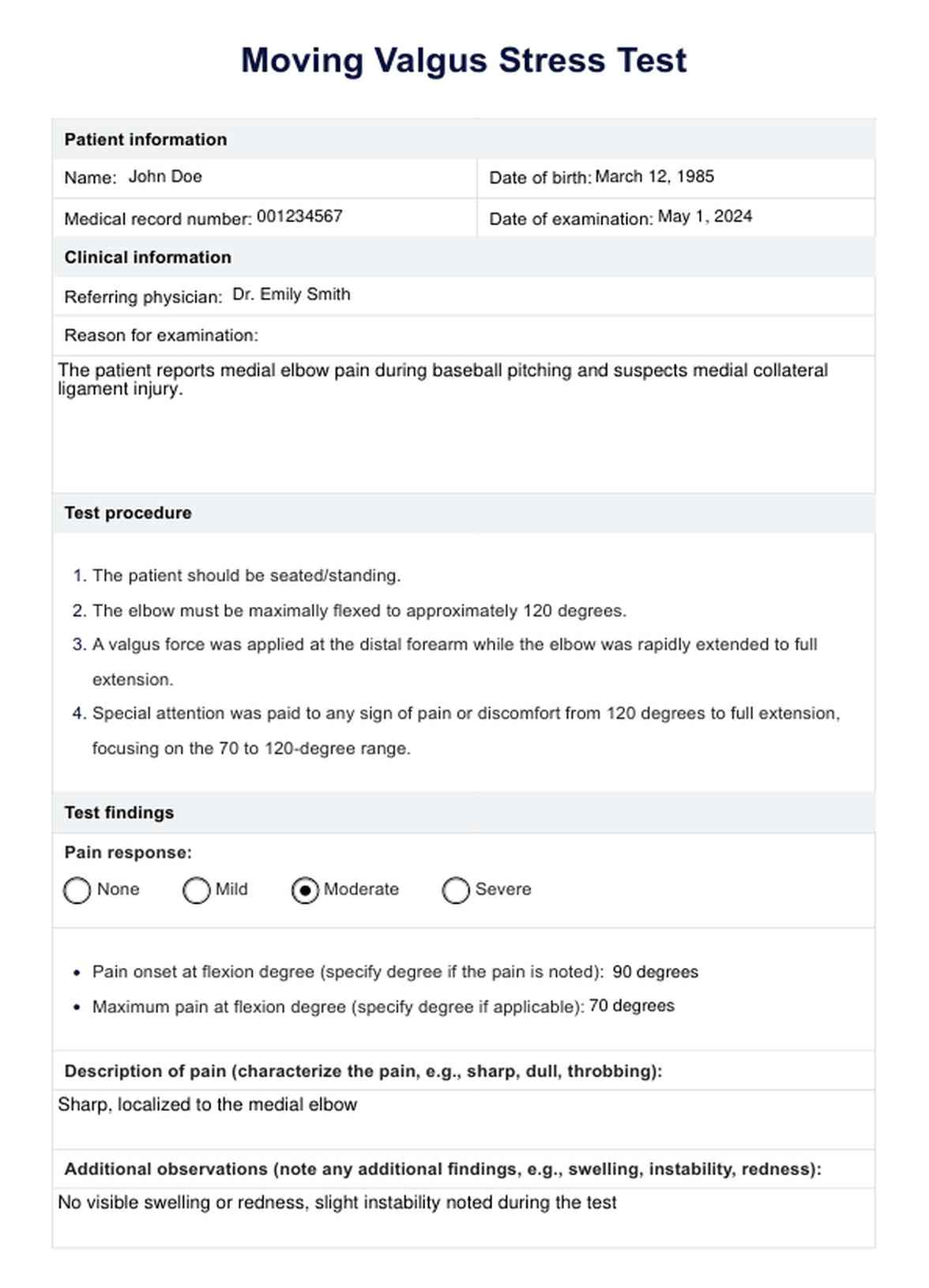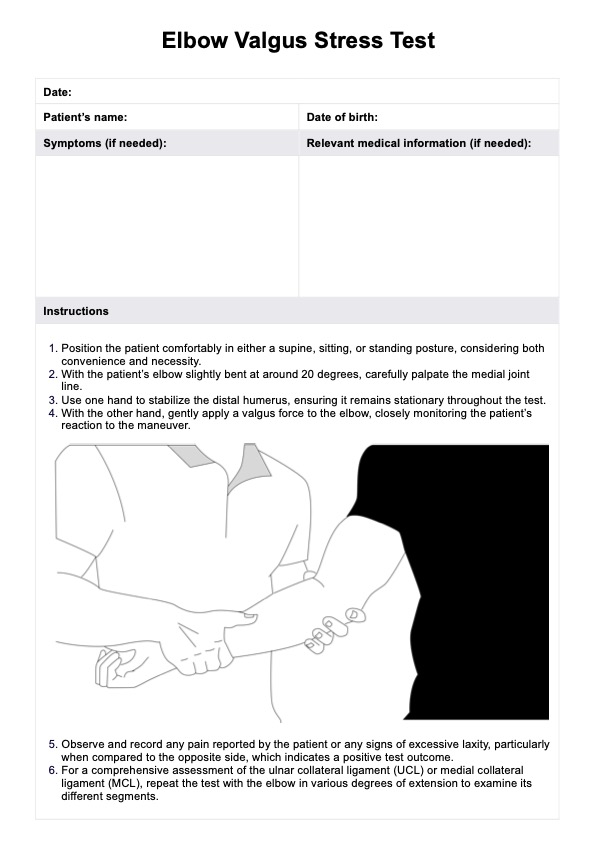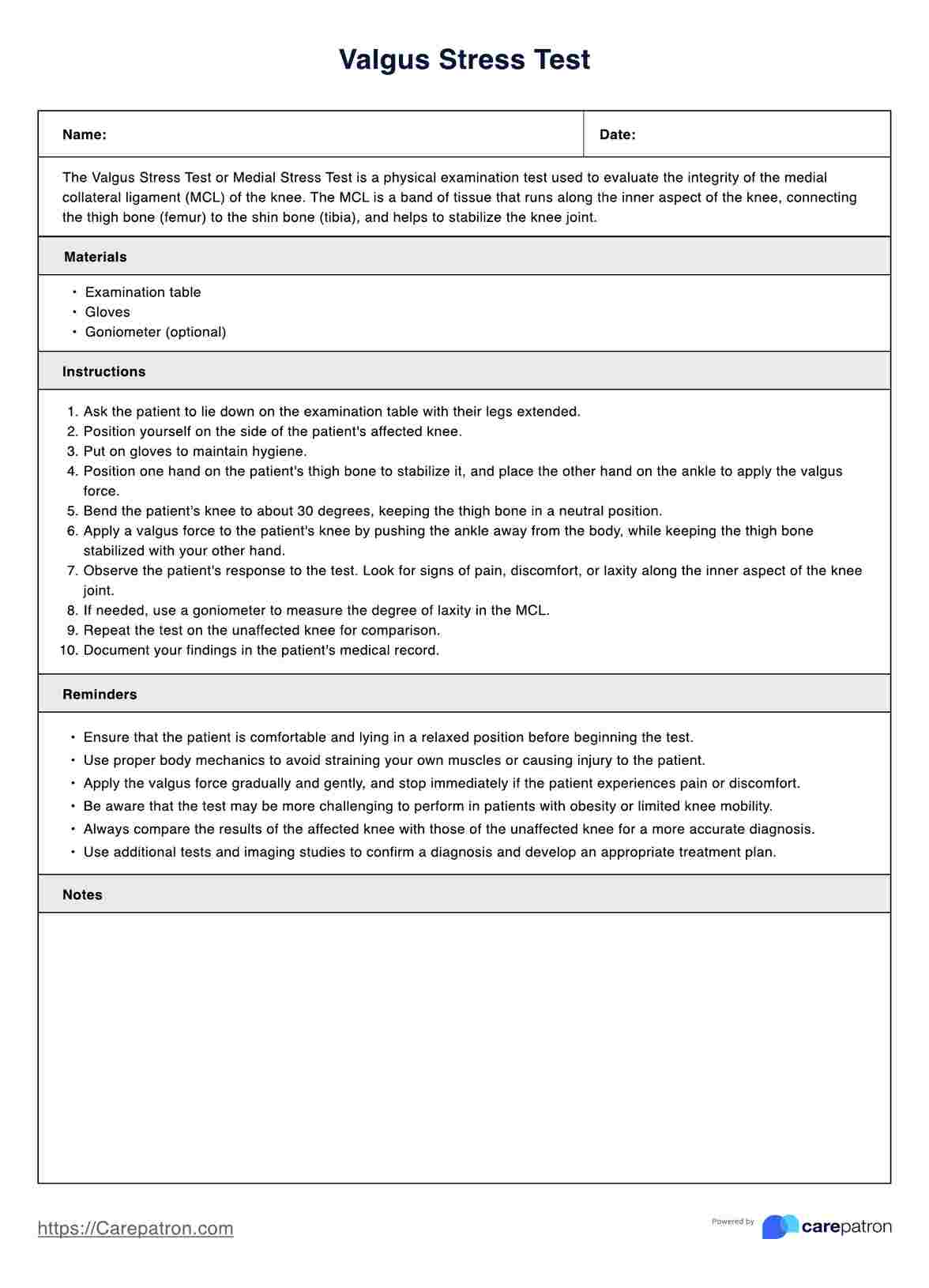Moving Valgus Stress Test
Learn more about the Moving Valgus Stress Test to assess knee ligament stability and diagnose injuries in patients with knee ligament length instability or ligamentous laxity.


What is an elbow MCL tear?
A medial collateral ligament (MCL) injury or elbow MCL tear occurs when the ligament inside the elbow is overstretched or torn, causing damage and pain.
This type of injury is common in athletes who participate in sports that involve repetitive throwing motions, such as baseball, javelin throwing, or lacrosse, as well as in individuals who experience a gradual weakening of the ligament over time.
The treatment typically involves physical therapy, rest, and pain management. Surgical intervention may sometimes be necessary to repair or reconstruct the damaged ligament. Therapy aims to restore movement and reduce pain, allowing the individual to return to their normal activities, including sports.
It's important to note that an elbow MCL tear can be diagnosed through physical examination, imaging tests such as MRI, and arthroscopy. The severity of the injury can be classified into grades, with grade 1 being a strain, grade 2 being a partial tear, and grade 3 being a complete tear. The treatment approach is tailored to the individual's needs and goals, restoring elbow stability and function.
Symptoms of this tear
The symptoms of an MCL tear in the elbow typically include:
- Pain inside the elbow might increase with activities involving throwing or pressure on the ligament.
- Swelling and tenderness in the area around the injured ligament.
- A feeling of instability in the elbow, especially when making specific movements.
- A decreased range of motion or difficulty performing tasks requiring elbow bending.
- Sometimes, a popping sensation or sound is present during injury.
Causes of this tear
Repetitive throwing motions in sports like baseball pitching, javelin throwing, and cricket can lead to overuse injuries. Similarly, direct blows from contact sports or falls can damage the joint. Even activities involving forceful or awkward bending or twisting of the elbow joint can strain the ligaments, causing pain.
Problems this tear may lead to
If not properly treated, an MCL tear can lead to several complications, such as:
- Chronic elbow instability, where the elbow feels loose or gives way during certain activities.
- Increased risk for other elbow injuries due to the compromised stability of the joint.
- Development of elbow arthritis over time, particularly if the joint remains unstable or the injury leads to abnormal wear and tear.
- Persistent pain and swelling can hinder performance in sports and affect daily activities.
An elbow MCL tear treatment often starts with conservative measures like rest, ice, compression, elevation (RICE), and physical therapy to strengthen surrounding muscles and stabilize the joint. In severe cases, or for athletes who require full functional recovery, surgical intervention might be necessary to repair or reconstruct the damaged ligament.
Moving Valgus Stress Test Template
Moving Valgus Stress Test Example
What is the Moving Valgus Stress Test?
The Moving Valgus Stress Test is a dynamic clinical examination technique used primarily to diagnose injuries to the elbow's medial ulnar collateral ligament (MUCL), often referred to simply as the medial collateral ligament.
This test is particularly relevant for detecting medial collateral ligament tears or medial collateral ligament insufficiency, conditions frequently seen in athletes who engage in overhead-throwing sports.
How is this test conducted?
The MCL is a vital stabilizer of the elbow joint. A physical therapist may perform a Moving Valgus Stress Test to assess it by applying a specific force while moving the elbow joint. Detailed breakdown of the test is as follows:
- The patient can be either seated or standing for the test.
- Passively flex the patient's elbow to maximum flexion.
- While maintaining the flexed position, apply valgus to the patient's wrist, pushing the elbow joint laterally. Simultaneously, extend the elbow joint to full extension.
- Pay close attention to any signs of pain or discomfort the patient reports. Particular focus is placed on the 70-120 degree range where the medial collateral ligament is most stressed.
How are the results interpreted?
A positive Moving Valgus Stress Test occurs when the patient experiences pain at the same medial collateral ligament that tears the elbow, particularly between 120 and 70 degrees of elbow extension and elbow flexion only. This range is critical as it typically indicates a partial or complete medial collateral ligament tear. Pain in this arc of motion is statistically significant and suggests MCL insufficiency.
How to use our Moving Valgus Stress Test template
To effectively use the Moving Valgus Stress Test template in a clinical setting, medical professionals should follow these steps:
Preparation
Before conducting the test, ensure you understand its purpose: to diagnose potential damage to the MCL. Familiarize yourself with the test mechanics, patient positioning, application of valgus stress, and identifying the flexion range where pain occurs.
During the patient visit
Collect essential information about the patient, including their name, date of birth, and pertinent medical history. Additionally, document the reason for the examination, focusing on any symptoms that may indicate a potential MCL issue. Observe signs like medial elbow pain or instability during specific movements, providing insights into the patient's condition and guiding further evaluation and treatment.
Findings and interpret the results
Follow the outlined testing procedure and document your findings in detail. Note any immediate pain response, including the specific degrees of the knee where the pain starts and intensifies. Describe the nature of the pain and any accompanying signs like swelling, redness, or joint instability.
Interpret the results based on the presence and characteristics of pain. A positive test, suggestive of an MCL injury, typically involves pain during the test. Document your interpretation and specific observations that support your conclusion.
You can utilize the Valgus Stress Test Template to improve your practice. The stress test template helps evaluate how well patients cope with physical or psychological stress, while the valgus stress test template assesses knee stability by measuring the response to applied forces.
Treatments for elbow MCL tears
Treatment for elbow medial collateral ligament tears depends on the severity of the injury and the patient's activity level. Primary treatment approaches are:
Non-surgical
When it comes to injuries to the elbow MCL, non-surgical treatments are usually the first course of action. These treatments are often suitable for patients whose daily activities do not heavily involve repetitive overhead motions.
The objective is to reduce pain, encourage healing, and restore function through conservative management techniques. Options include:
- Rest: Patients should avoid or significantly reduce activities that exacerbate pain, particularly overhead throwing or lifting. Modified activities or workload adjustments can minimize stress on the elbow.
- Ice and compression: Applying ice packs and compression wraps can help minimize swelling and reduce pain. In the acute stage, this should be done for 15-20 minutes every few hours.
- Anti-inflammatory medications: Non-steroidal anti-inflammatory drugs (NSAIDs) like ibuprofen can control inflammation, helping to reduce pain and swelling. They should be used under a healthcare provider's guidance.
- Bracing: An elbow brace or splint provides extra support and limits the range of motion, reducing stress on the ligament while it heals.
- Physical therapy: Tailored exercises strengthen muscles around the elbow to enhance stability and function while improving flexibility.
Surgical
These treatments are considered for patients with complete MCL tears or those who do not respond to non-surgical options. Athletes and those with high functional demands on their elbows may also require surgery to regain full performance. Surgical interventions aim to restore ligament stability and enable patients to return to their desired activities.
- Ligament repair: This procedure directly repairs the damaged ligament tissue if it remains partially attached and viable. It’s less invasive and often used for specific partial tears.
- Ligament reconstruction (Tommy John surgery): This involves replacing the damaged ligament with a graft, usually from the patient’s tendons or a donor. It is commonly used for athletes and those needing a full range of motion and strength in the elbow.
Commonly asked questions
The valgus stress test applies lateral-to-medial pressure on the medial elbow side, stressing the medial collateral ligament (MCL) to assess its integrity.
A positive stress test for the medial typically indicates either a static test or a partial or complete tear of the medial collateral ligament (MCL).
A first positive test result identifies medial collateral ligament (MCL) instability or insufficiency, often due to a ligament tear.









































































































